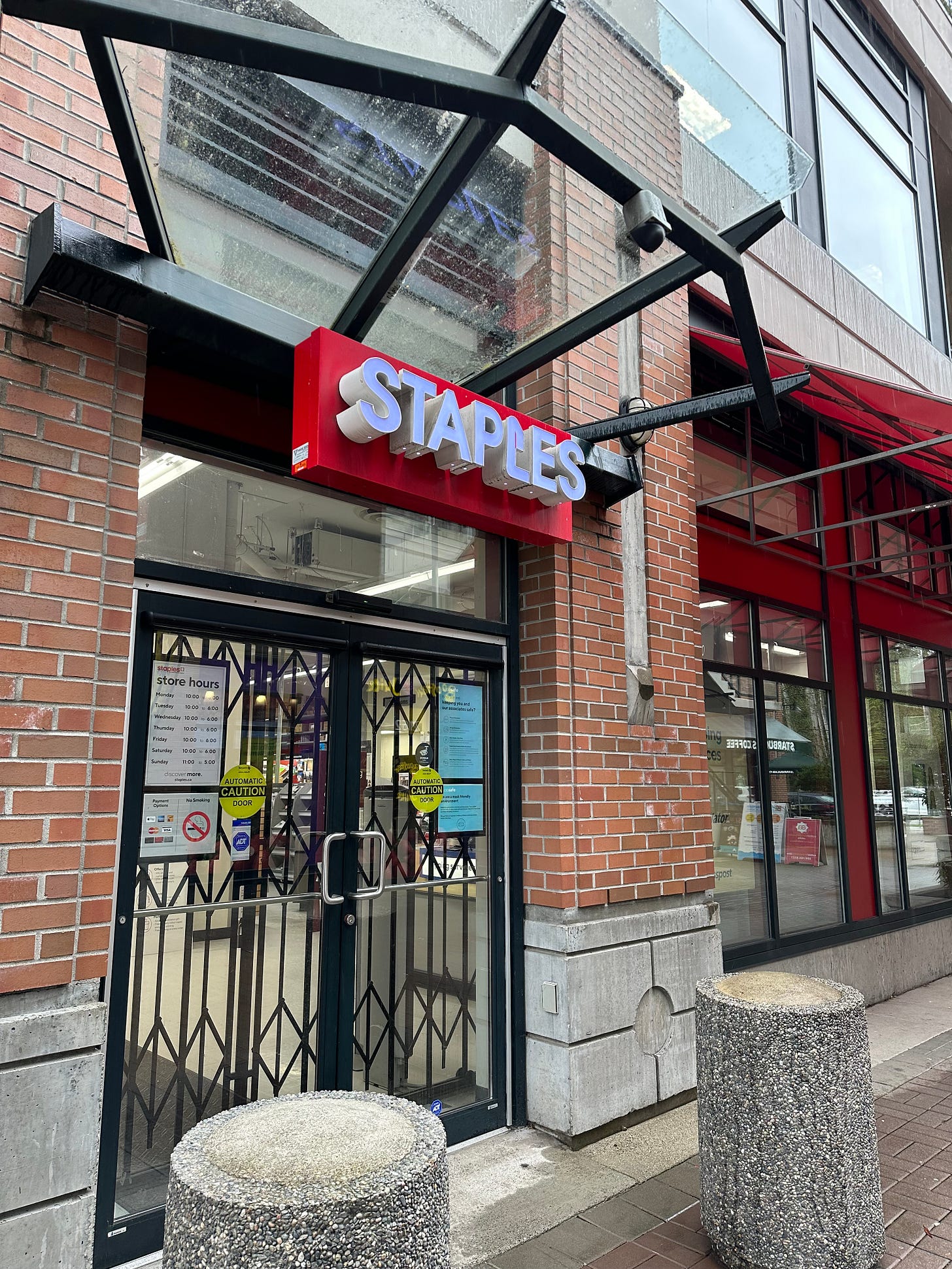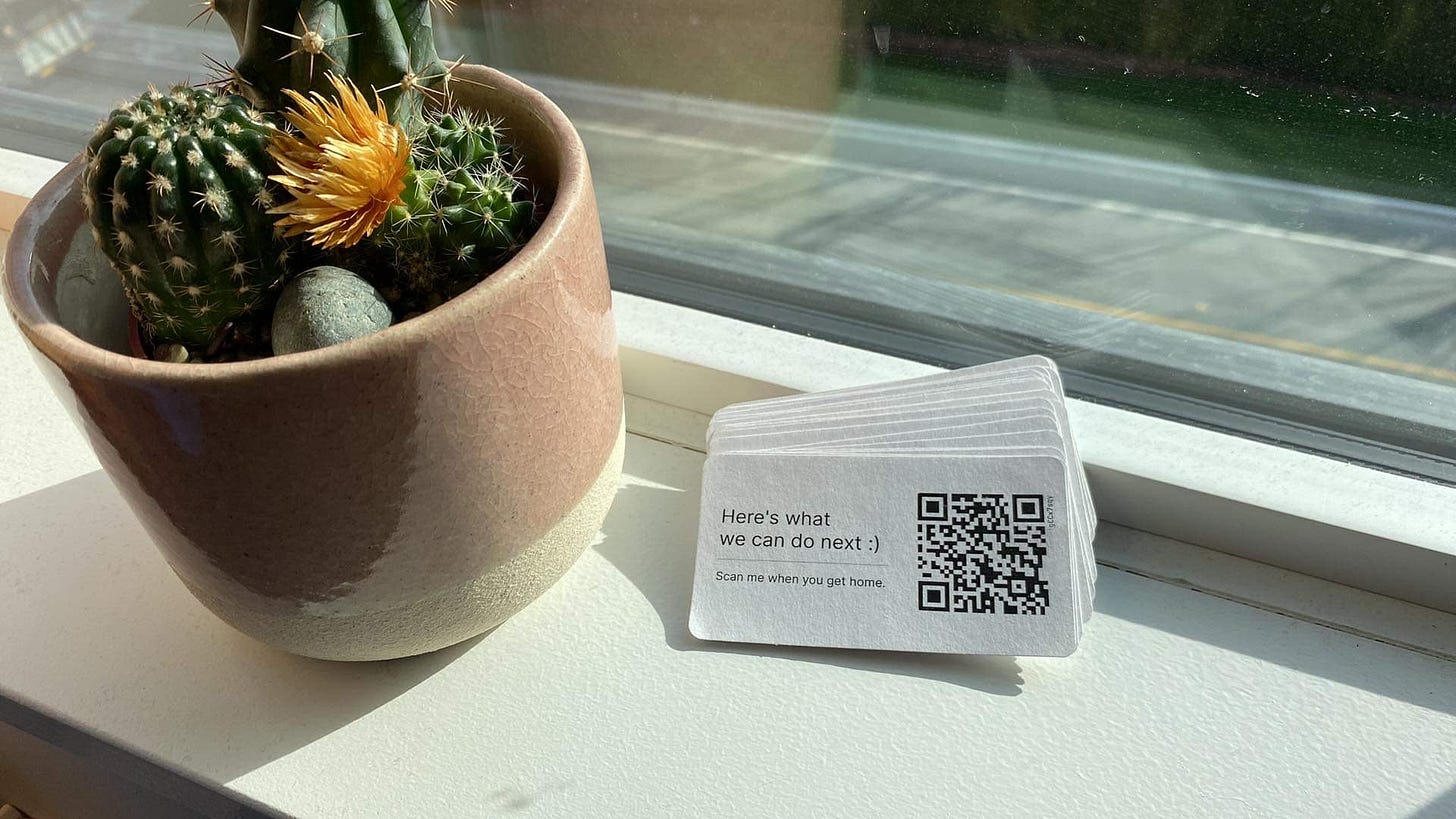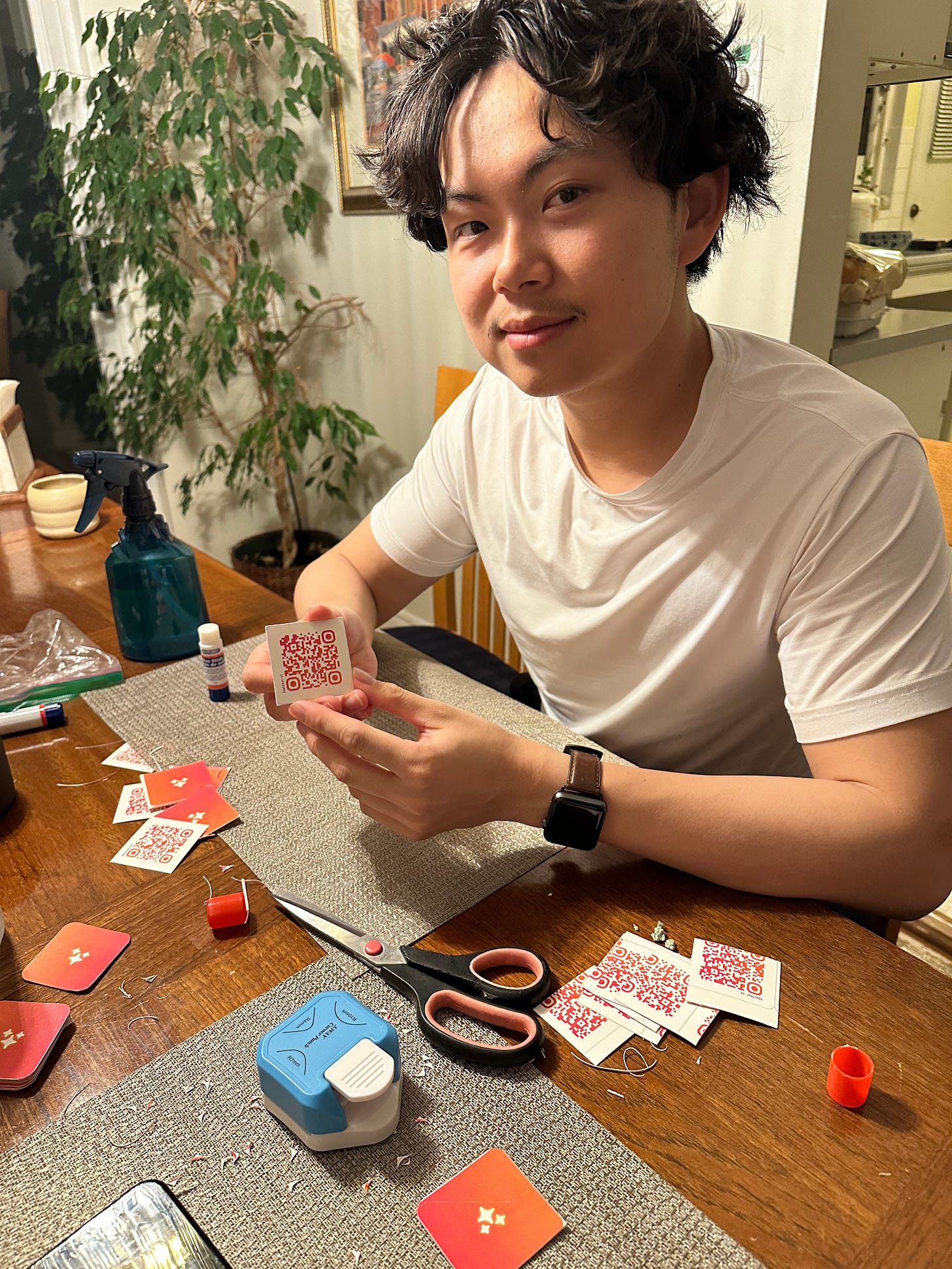Test, Test, Test
The Journey To Refine Prompt
We have been busy. Over the past few weeks, Scott, Kai, and I have been testing Prompt to see if there is a problem-solution fit. The nice thing about having built an MVP already is that our product is incredibly easy to demo, and we quickly reach an “aha” moment with people.
"Wow, how did you do that?!” most users say, when they scan our QR codes and find a page personalized to them, with their name at the top. We want them to feel special, but is that enough to make them buy?
Before I dive into how we've been testing Prompt, here's some more background on our current process to create cards and the inspiration for the idea in the first place!
Thanks, Staples!
To print the cards, Scott and Kai have been going to the local Staples on campus and using their printers. We've been testing different kinds of card stock, designs, copy text, the list goes on! Scott got a rounded corner puncher, and we've been using that to create a more "premium" experience and differentiate our cards from just ordinary business cards. All in all, our total materials cost for printing out a pack of cards is about $1 for 20. In the future, we may consider partnering with a local print shop and following a dropshipping model of sorts, wherein we send our orders to them, and then they fulfill and deliver them to our customers (and we use super luxe paper). But for now - the Staples runs it is! The scrappiness has been a lot of fun - although we have almost gotten caught multiple times switching out the paper tray in the printers at Staples to use our card stock
Agile Training Bootcamp? How does that come in?
Another inspiration for Prompt Cards (that I forgot to mention in our first blog post) is an Agile Training Bootcamp. Scott and Kai attended a Product Management conference a couple of months ago and noticed they were handing out a ton of business cards. They also noticed that they would spend 10-15 minutes talking to each potential customer/company, trying to convince them that they needed Agile training and the benefits, and how they were probably implementing Agile wrong. That's when the spark of an idea "clicked" - "What if business cards could be customized and tailored on the fly with a follow-up that shows how my business can solve the pain points of a potential customer?" "How can we use these business cards as a mechanism to track in-person relationships and ensure that the effort a sales professional made to build a relationship doesn't get lost?" Enter Prompt.
Everything, Everywhere, All at Once
To test Prompt, we've taken every opportunity to gather feedback and explore potential use cases. We have been trying to determine our beachhead market. We've gone to home-reno trade shows, canvassed local bike shops on Main Street, joined calls for small businesses, given out cards to our friends, reached out to mentors in our networks for advice, and pitched to everyone and anyone - we're trying to do it all. The goal has been to collect as much feedback as possible and narrow down our target customer and use case.
The challenge we've faced is trying to be everything to everyone. It's a Catch-22. Instead of starting with a clearly defined user and problem space and working towards a solution, we've been exploring various avenues to find the perfect fit. Not the best way to build a product - very solution-in-search-of-a-problemy, but when you can build software really quickly (thanks, Kai), we think it's best to build a quick MVP and iterate, iterate, iterate (based on feedback).
We chatted with the Agile Training Bootcamp company, and they said they’d definitely be customers; however, they only attend conferences once or twice a year.
Fine-tuning Our User, Recipient, and Product Profiles
From the chats we've been having, we've been fine-tuning our user, recipient, and product profiles (at a high level) from the B2B POV.
User (the person giving out the card):
They value the personalization/customization aspect
They appreciate the phygital aspect. They like giving something to someone - it's more special, more memorable, and feels like a gift
They are highly knowledgeable about the product and are willing to go the extra mile (customizing a card for the other person) because they receive a kickback/commission
They understand the value of follow-ups and are determined to make a sale
They want to track the customers/relationships they make in person and digitize them
Recipient Profile:
They are looking for expert advice/feedback
They may not know what they want right off the bat, but they are open to taking advice
Product/Industry Profile:
The product is a mid-tier item, not too cheap (doesn't require much consideration), and not too expensive (requires a lot of consideration). The product sits at that perfect midpoint.
The sales funnel is relatively short (customers are willing to make a purchase within a few weeks of chatting with someone)
Challenges with Prompt
A lot of people think that Prompt is a cool concept - "it's like a magic trick." However, we've found that our solution doesn't always provide a clear order of magnitude improvement. Many people have asked questions like, "Why wouldn't I just follow up over LinkedIn or Instagram instead?" and "Aren't physical business cards being phased out?". While Prompt cards are a neat idea, they don't necessarily provide a clear incentive or guarantee a sale - they're too far from the transaction.
From our testing, we've found that Prompt currently occupies an awkward spot between marketing and sales-led strategies. The physical card makes it easy to just hand out, but customizing a card requires a personalized follow-up. Furthermore, what has become apparent is that there is a clear power imbalance between the sales professional and the customer. The sales professional wants to make the sale (and is willing to go to great lengths to do so), but with our cards, it puts the onus on the customer to make the next follow-up. The sales professional wants to and has the incentive to control the conversation (not the other way around).
We have also been validating the hurdles with our flow. How do we make activating the cards a natural part of the user journey? Is it too much work to set up links in advance, creating a barrier? Can we really ensure that the recipient opens up the QR code, and do they know it's personalized to them, or will they throw it out thinking it’s just a generic business card?
What We Are Learning
We have been learning a ton through this process.
Order of Magnitude Improvements: One of our biggest learnings (which I briefly alluded to) was the importance of an order-of-magnitude improvement. Our solution needs to be 10x better than the next best option for a customer to even consider switching over and making our solution a part of their user journey. Plus, what is considered an order of magnitude improvement may vary depending on the vertical.
Fail Quickly: You never "really" know until you try. You can have all the hypotheses in the world, but until you get something into the hands of potential customers, you're just left guessing. From creating an MVP and handing out the cards to potential customers, we have been learning the importance of testing, gathering feedback, and failing quickly.
Feedback Gathering: Getting "good" and honest feedback is hard. We are slowly getting better at moving past the initial "Ohh, this is cool" and getting to the more useful: "Here are the concerns that I have…"
Incomplete Information: We will never have perfect information. And sometimes we will need to make a decision based on our intuition and truly trust our gut. Although in an ideal world, it would be great to achieve statistical significance for each test, is that really feasible?
User Journey Alignment: We're learning the importance of habit formation, and having our product be a seamless step in the user journey. How do we make Prompt a natural part of the user journey and reduce barriers to entry in activation?
And finally, pitching is hard (we already knew this). But condensing our value proposition into a quick elevator pitch is a skill that needs refining.
To Pivot or Not to Pivot?
From all of this, the biggest question on our mind has been whether to pivot or not to pivot. Our chats with potential customers have left us with more questions than answers. It's something we are going to mull over in the next couple of weeks.
Next Steps
In terms of the next steps, we are going to continue testing Prompt! Giving out packs, and getting other people to use the cards. We have set a deadline for these tests at the end of the month. There is definitely a bit of a sunk cost fallacy here, but we are recognizing the opportunity cost of working on this as opposed to other ideas.
Overall, we are learning a lot, growing a lot, and enjoying the process!
Oh, and we almost forgot to mention - we're heading to Toronto in a couple of weeks (Scott and I just have to finish our finals first, sigh)






